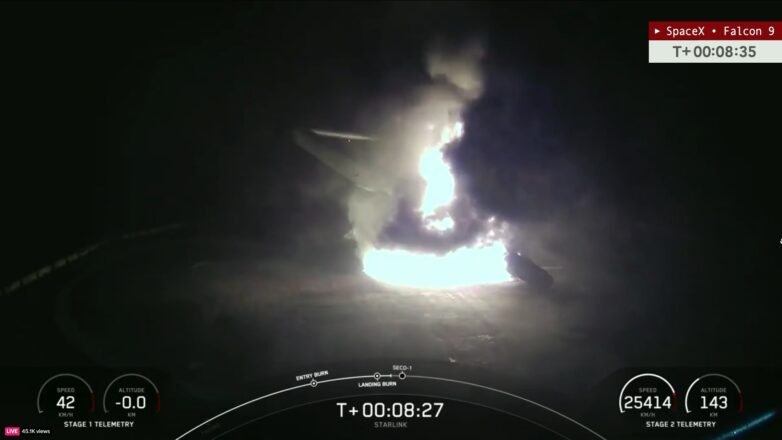

Update 5:20 am EDT: SpaceX is scrubbing the Starlink 9-5 launch from Vandenberg Space Force Base to allow more time to review data from the B1062 landing failure.
For the first time in more than three years, SpaceX lost one of its reusable Falcon 9 boosters during a landing attempt in the middle of the Starlink 8-6 mission on Wednesday morning. As the drone touched down, “A Shortfall of Gravitas”, a green flash could be seen around the Merlin engines before the engine section was engulfed in flames and the booster fell and exploded.
While the recovery of the booster is a secondary part of the mission compared to the deployment of the 21 Starlink satellites, SpaceX’s business model is based on the reuse of the boosters of the first stage of its rockets. Whatever problem led to the end of the disappearance of the booster, tail number B1062, made a series of 267 successful booster landings.
After sending 21 Starlink satellites on their way to orbit, the Falcon 9 booster 1062, making its 23rd flight, overturned and exploded as it landed on the drone ship “A Shortfall of Gravitas”. It was the first Falcon 9 landing failure since February 2021. Watch a replay of our live… pic.twitter.com/Dquqk2DL2R
– Spaceflight Now (@SpaceflightNow) August 28, 2024
Before the August 28 accident, the most recent failure occurred on February 16, 2021, when booster B1059 met its end in the middle of the Starlink 19 v1.0 mission. That landing attempt was with SpaceX’s ‘Of Course I Still Love You’ drone.
SpaceX decided to move forward with the launch of the Starlink 8-6 mission after weather concerns prevented the launch of four astronauts on the Polaris Dawn mission. The company announced that it will launch consecutive batches of Starlink satellites on Falcon 9 rockets from the Cape Canaveral Space Force Station and Vandenberg Space Force Base on Wednesday morning.
Starlink 8-6 was the first to hit, launching from Space Launch Complex 40 (SLC-40) at 3:48 am EDT (0748 UTC). It was set to be followed by the Starlink 9-5 mission from VSFB, but SpaceX opted to hold off for now “to give the team time to review the booster landing data.”
Wednesday morning’s flight of B1062 marked a record 23rd launch of a booster. This made the flight leader for SpaceX. Previously, it supported the launches of two GPS satellites, two astronaut missions (Inspiration4 and Axiom Mission 1) and 15 Starlink flights.
The problem occurred about 8.5 minutes after liftoff, when B1062 made its ASOG landing attempt. It would have been the 342nd booster landing to date.
On board the flight were 21 Starlink satellites, including 13 featuring Direct to Cell capabilities. The successfully deployed satellites bring SpaceX up to 155 DTC Starlink satellites launched to date.

During their mission, the astronauts of the upcoming Polaris Dawn mission will perform an in-orbit demonstration of the Starlink connection. Mission commander Jared Isaacman told Spaceflight Now in July that this will be a good step to help promote communication in space.
“There is only so much capacity on TDRSS satellites (Tracking and Data Relay Satellite System). Ground stations, there are not many. They are also in demand. And if you can create a constellation, not only in the low orbit of the Earth, but even in lunar orbit, you can transmit very efficiently over laser links,” said Isaacman. “It’s a good step in that direction and SpaceX is already moving in that direction of making those laser links in Starlink available to other suppliers. So, that’s really great just for the whole commercial space.”
Polaris Dawn is now set to launch no earlier than Friday, August 30, after weather conditions expected for its planned return from space pushed the launch date back to Wednesday.
Our launch criteria are heavily limited by expected splashdown weather conditions. With no ISS rendezvous and limited life support consumables, we must be absolutely sure of the reentry weather before we launch. As of now, conditions are not favorable tonight or tomorrow, so… https://t.co/Zpd3pY5kNF
– Jared Isaacman (@rookisaacman) August 28, 2024
